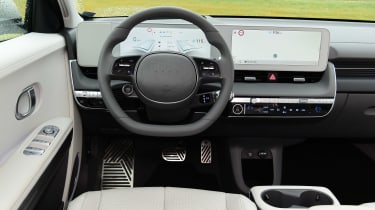New Hyundai Ioniq 5 2021 review
The new Hyundai Ioniq 5 has arrived and it's simply one of the best electric cars on sale right now
Verdict
If the Ioniq 5 is a signal of intent from Hyundai, then rival car brands should be worried. This showcase of the Korean firm’s next generation electric car tech is hugely impressive in almost every area; from the performance to the charging speeds, few rivals can match it for the money. That it also looks unlike anything else on sale, inside and out, has great tech and is relaxing to drive, means there’s very little to fault.
This is the all new Hyundai Ioniq 5. The first car that will showcase the Korean brand’s second generation EV tech - quite an ominous thought for rivals considering that, at the more affordable end of the electric car market, Hyundai and its sister brand Kia already build some of the best offerings in the business.
This time, however, Hyundai is aiming higher. This is a car that has set its sights on premium rivals, with cars like the Audi Q4 e-tron and the upcoming Tesla Model Y seen as competition as much as the likes of the Volkswagen ID.4 and Ford Mustang Mach-e.
With premium construction comes a premium design. The Ioniq 5 is a world away from the Kona Electric or indeed anything else on the road; the retro-modern shape is covered in cool details. The multi-slotted glowing front panel, the 8-bit headlights (made from 256 individual LED ‘cubes’) and bold side surfacing are just some of the features that have created a proper head-turner.
Used - available now

2021 Tesla
Model 3
33,412 milesAutomaticElectric
Cash £17,800
2019 Vauxhall
Corsa
23,352 milesAutomaticPetrol1.4L
Cash £10,800
2023 Tesla
Model 3
81,914 milesAutomaticElectric
Cash £16,200
2022 Toyota
C-HR
15,432 milesAutomaticPetrol1.8L
Cash £23,700Unlike Hyudai’s previous EVs, which used architecture designed to be compatible with combustion-powered offerings, the Ioniq 5 uses the brand’s Electric Global Modular Platform. It’s the first car to ride on the fully electric architecture, with the equally dramatic looking Kia EV6 set to be the next model to hit the roads.
The move upmarket has also resulted in an increase in size. Don’t let those neat proportions fool you - when you realise that the wheels this car rides on measure a whopping 20 inches, you realise that it’s almost like Hyundai has taken the blueprints for a family hatchback and clicked ‘select all’ then ‘resize 110 per cent’. At 4,635mm long and 1,890mm wide, the Ioniq 5 is longer and wider than Hyundai’s Tucson mid-size SUV - though its roofline is slightly lower. Perhaps more significant is the wheelbase; at 3,000mm, the gap between the front and rear axles is a couple of millimeters longer even than that on an Audi A8.
It’s a stat that really makes itself known once you swing open the huge back doors - the Ioniq’s cabin is simply vast. The floor is almost completely flat throughout, and rear occupants get genuinely limo-like levels of legroom. Yet compared to the finest luxury saloons, the Ioniq’s open plan feel and big windows make it so much brighter and more airy. The boot floor is high and the space is fairly shallow, but the area it covers is so huge that there’s still an impressive 527 litres of volume on offer.
Ahead of the driver sit a pair of screens. The central infotainment display uses a similar interface to other Hyundai models, but with cleaner graphics. The digital instrument display is equally clear to read - they’re not quite the sharpest resolution you’ll find in an EV (Tesla still holds that title) but everything is very logical and intuitive. The driver assist systems are particularly well integrated; on versions equipped with blind spot cameras, the images are displayed in real time in the instrument panel when the indicators are turned on.
It’s comfy, too. The seats are squishy yet supportive, while those in the front can recline almost completely - ideal if you fancy a quick nap when the car is charging.
Not that you’ll need to wait too long. The Ioniq 5 is capable of adding up to 62 miles of range in just five minutes, and a 10-80 per cent top-up takes as little as 18 minutes. That’s a result of one of its standout features - the ability to support 800-volt charging. That's double the usual standard of current EVs and has been reserved for high-end models like the Porsche Taycan and Audi e-tron GT until now.
There are two battery options and three power outputs to choose from. The range kicks off with a 58kWh battery paired with a single 168bhp motor driving the back wheels, which is enough for a 0-62mph time of 8.5 seconds and a range of 238 miles. The middling model has the best range; a step up to a 73kWh battery bumps the distance possible between charges to 280 miles. This also comes with an increase in power to 214bhp, which helps to knock a second off the 0-62mph time.
The top spec model driven here keeps that 73kWh battery pack, but adds a second motor, this time at the front, for a combined total of 301bhp and 605Nm of torque. While range drops slightly to 267 miles, this version is significantly quicker - 0-62 takes a hot hatch-like 5.2 seconds.
Though unless you mash the right pedal towards the bulkhead, all remains very calm. Twist the column mounted gear selector to drive, and the 5 glides away silently and smoothly. It’s all impressively easy and tranquil.
The side effect of carrying big batteries around is that electric vehicles tend to weigh a significant amount - and it’s no different for the Ioniq 5, which in its twin-motor configuration here, weighs just over two tonnes. Chasing razor-sharp handling, then, is something of a pointless exercise; instead Hyundai has focussed on comfort.
That’s not to say it’s all at sea through the turns - far from it. That mass is kept low down, so despite relatively soft suspension, body roll is kept neatly in check. The steering isn’t brimming with feedback, but it is precise and its speed is nicely matched to the responses of the chassis.
The benefit of that suspension setup is a comfortable ride - particularly as speeds increase. At lower speeds, those 20-inch wheels can cause a little bit of fidget over smaller bumps, but those soft seats manage to take up plenty of the slack here.
All of this tech and the impressive driving stats make it sound like the Ioniq 5 will be rather pricey - but compared to its rivals it really isn’t. Prices start at £36,995 for the entry-level single motor option, while even this version, with its 301bhp output, reclining front seats and lane departure warning cameras is £48,145. When you consider it’s possible to spec up the slower accelerating, slower charging Audi Q4 e-tron to well beyond £55,000, then that figure starts to look entirely reasonable.
So are there any downsides? Well very few. That fidgety ride aside, it’s a little irritating that there’s no rear wash/wipe - on wet roads the rear window quickly becomes obstructed. That we’re complaining about a missing wiper blade sums up what a triumph this new Ioniq 5 really is.
| Model: | Ioniq 5 Ultimate 73 kWh AWD |
| Price: | £48,145 |
| Powertrain: | 72.6kWh/2x electric motors |
| Power/torque: | 301bhp/605Nm |
| Transmission: | Single-speed automatic, four-wheel drive |
| 0-62mph: | 5.2 seconds |
| Top speed: | 115mph |
| Range: | 267 miles (est) |
| Charging: | 220kW (10-80 per cent in 18mins) |
| On sale: | Now |










